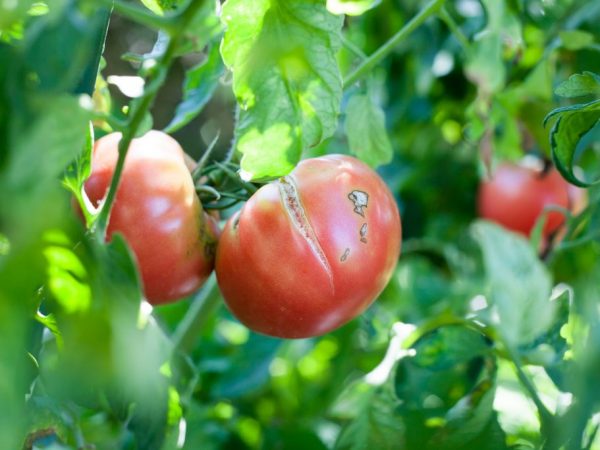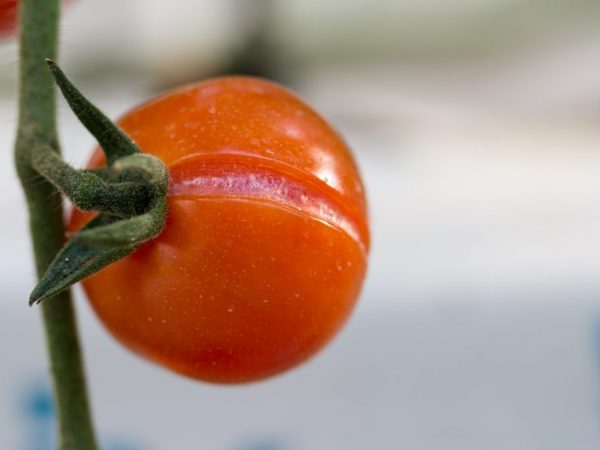Why do tomatoes crack on a bush in a greenhouse
To increase the quality of the harvest, gardeners build greenhouse shelters, but they do not protect vegetables from external damage and infection. Consider why tomatoes crack on a bush in a greenhouse.

Why do tomatoes crack on a bush in a greenhouse
Variety selection
The crack resistance of tomatoes depends on the variety. Yellow tomatoes with a firm flesh structure are more prone to cracking than red, soft varieties. The breeders have developed less cracking hybrids "Harlequin", "Centaur", "Favorite", "Our Masha", "Beautiful Lady", "Diva", "Vasilievna", "Straus", "F1 Boomerang" and "Podmoskovny".
Other varieties are more demanding on growing conditions.
Tatiana Orlova (Candidate of Agricultural Sciences):
Affects the resistance to cracking and the condition of the skin of the fruit. Cultivars whose skin cells have good elasticity are less susceptible to this phenomenon.
Soil moisture level
Under polycarbonate in hot weather, the soil dries up, due to insufficient moisture, the skin on tomatoes coarsens. After watering, growth resumes, the delicate structure of the plant does not withstand the pressure of moisture and bursts. To avoid such a problem, the walls of the greenhouse are recommended to be watered with milk of lime. The sun's rays are reflected and do not penetrate inside. Also, the greenhouse is covered with a light cloth made of natural fabric. Watering the soil is carried out evenly and regularly.
Temperature and humidity
Tomatoes are thermophilic plants. Tomatoes are recommended to be watered after 5 pm. If the night temperature was below 13 ° C, watering is carried out at about 11 in the morning. In the daytime, at high air temperatures, ventilation is necessary. To prevent the plants from getting a heat shock, the door in the greenhouse is opened no later than 7-8 a.m. The moisture content of the soil should not be less than 50%, but it is also not necessary to fill the soil.
Green fruits have dense flesh, so they are more likely to crack. In autumn, there are still many fruits on the bushes, but their growth is no longer desirable, so vegetable growers pinch the shoots. As a result of this procedure, water from the roots enters the fruit in large quantities. They crack from excess moisture.
Insufficient nutrition with useful substances

Nutrient deficiencies can cause cracking.
Lack of certain nutrients also leads to the fact that tomatoes crack in the greenhouse:
- With a lack of calcium, the leaves acquire a yellow color and gradually die off.
- With a lack of copper, the leaves turn white, slow down growth, and the shoots weaken. Peduncles wither and fall off.
- With a lack of nitrogen, the formation of the plant slows down, the color of the leaves changes, the fruits look unripe and sick.
- With an insufficient amount of potassium, the fruits turn black inside.
- With a lack of boron, the plant becomes bushy and infertile.
- With a lack of magnesium, tomatoes ripen early, but do not grow.
The quality of the tomato crop is also affected by nutrient overload.
How to prevent cracking
To prevent the tomatoes from cracking, they must be properly looked after. If there are signs of a lack of trace elements, top dressing is performed until the plants are completely healed.
Uniform and regular watering of tomatoes is important during the period of root development. The water is fed directly to the roots. In sunny weather, watering is carried out every 3 days, and in rainy weather - once every 5 days.
During fruit ripening, the frequency of watering is reduced to once a week. Water is poured into the hole, waiting for it to be absorbed, then watered again. Drip irrigation is carried out using improvised means. For this:
- the bottom is cut off in plastic bottles;
- make holes in the lids;
- funnels are inserted near the plant with the neck down, fill them with water.
The use of moisture-absorbing soil protects the soil from drying out. After watering, to maintain a moisture level in the greenhouse of about 60-75%, the soil is mulched with cut grass.
Tatiana Orlova (Candidate of Agricultural Sciences):
Cracking of tomato fruits is not only a deterioration in its presentation. The biggest problem is that cracked fruit is the gateway to any fungal or bacterial infection. Fruits with cracks simply rot after a short time. If a tomato is cracked at the stage of blanche or brown fruit, it rots without ripening. Therefore, the prevention of cracking is the preservation of the quantity and quality of the tomato crop.



